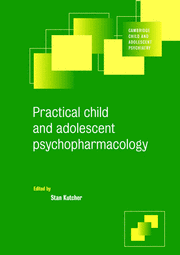Book contents
- Frontmatter
- Contents
- List of contributors
- Preface and acknowledgements
- 1 Child and adolescent psychopharmacology at the turn of the millennium
- 2 Developmental psychopharmacology
- 3 Clinical aspects of child and adolescent psychopharmacology
- 4 Depression
- 5 Bipolar mood disorders: diagnosis, etiology, and treatment
- 6 Schizophrenia and related psychoses
- 7 Obsessive–compulsive disorder
- 8 Anxiety disorders
- 9 Attention-deficit/hyperactivity disorder
- 10 Pervasive development disorder
- 11 Aggressive behavior
- 12 Adolescent substance use disorder
- 13 Tic disorders and Tourette's syndrome
- 14 Eating disorders and related disturbances
- 15 Medical psychiatric conditions
- Index
13 - Tic disorders and Tourette's syndrome
Published online by Cambridge University Press: 31 August 2009
- Frontmatter
- Contents
- List of contributors
- Preface and acknowledgements
- 1 Child and adolescent psychopharmacology at the turn of the millennium
- 2 Developmental psychopharmacology
- 3 Clinical aspects of child and adolescent psychopharmacology
- 4 Depression
- 5 Bipolar mood disorders: diagnosis, etiology, and treatment
- 6 Schizophrenia and related psychoses
- 7 Obsessive–compulsive disorder
- 8 Anxiety disorders
- 9 Attention-deficit/hyperactivity disorder
- 10 Pervasive development disorder
- 11 Aggressive behavior
- 12 Adolescent substance use disorder
- 13 Tic disorders and Tourette's syndrome
- 14 Eating disorders and related disturbances
- 15 Medical psychiatric conditions
- Index
Summary
Introduction
The pharmacologic treatment of Tourette's syndrome (TS) changed our fundamental understanding of TS. Prior to the 1960s, TS was characterized as a disorder of the mind, and tic symptoms the result of psychologic mechanisms. The discovery in the early 1960s that haloperidol is an effective tic suppressant (Caprini and Melotti, 1961; Seignot, 1961) resulted in a new conceptualization of TS – a condition of the brain, not a condition of the mind. This conceptual change stimulated an increase in both basic and clinical research, but also decreased the stigma people with severe TS so often endured.
The responsiveness of tics to medications has given us clues as to which brain regions, neurocircuits, and neurochemicals are likely to be involved in the pathophysiology of TS. The responsiveness of tics to medications has also increased our hope that by identifying persons with the disorder we could provide effective treatment. Subsequent to the identification of effective treatments, studies were undertaken of this seemingly rare disorder to identify the prevalence, life course, clinical phenomenology, and associated conditions. The results of this research suggest that TS is not as rare as previously thought, that TS is not only brain based but also heritable, and that other psychiatric disorders frequently co-occur in people with TS.
The discovery that haloperidol suppressed tics has also resulted in a whole class of medications, normally used for the treatment of psychosis, being used for tic suppression.
Keywords
- Type
- Chapter
- Information
- Practical Child and Adolescent Psychopharmacology , pp. 382 - 409Publisher: Cambridge University PressPrint publication year: 2002
- 1
- Cited by



